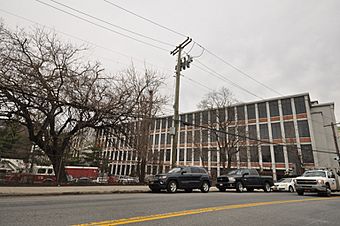Alexander Smith Carpet Mills Historic District facts for kids
Quick facts for kids |
|
|
Alexander Smith Carpet Mills Historic District
|
|

View from Walnut Street
|
|
| Location | Roughly bounded by Saw Mill River Rd., Orchard St., Lake and Ashburton Aves., Yonkers, New York |
|---|---|
| Area | 38 acres (15 ha) |
| Built | 1871 |
| Architectural style | International Style |
| NRHP reference No. | 83001832 |
| Added to NRHP | August 11, 1983 |
The Alexander Smith Carpet Mills Historic District is a special area in Yonkers, New York. It is called a "historic district" because it has many old buildings that are important to history. This district includes 85 buildings that were once part of a big carpet factory.
These buildings include 19 different factory buildings and six rows of homes. These homes were for the workers. They were built between 1871 and 1930. The area is near Getty Square and the Saw Mill River.
The main factory building was first built in 1871. It was made bigger between 1876 and 1883. This building is three stories tall and has a unique style called Second Empire. It also has two tall towers.
The homes for workers were built between 1881 and 1886. This area was known as Moquette Row. Many workers who lived here were immigrants. They came from countries like Scotland, Ireland, and Ukraine.
The carpet factory was started by Alexander Smith (1818-1878). His company closed the Yonkers factories in 1954. They moved to Greenville, Mississippi. At that time, about 2,400 people worked there. During World War II, about 7,000 people worked at the factory.
Alexander Smith and an engineer named Halcyon Skinner invented new machines here. Skinner designed a special machine called the Axminster power loom. This machine made it much easier and faster to make carpets. He got a patent for his invention in 1877. This meant other companies had to pay to use his loom.
The Alexander Smith Carpet Mills Historic District was added to the National Register of Historic Places in 1983. Today, some artists work in two of these old factory buildings. They are part of the YoHo Artist Community.
What is the Carpet Mills Arts District?
The Carpet Mills Arts District is a special area in Yonkers, New York. It was officially created in March 2016. The City Council voted for it, and Mayor Mike Spano signed the plan in April 2016.
This arts district uses the old factory buildings from the Alexander Smith Carpet Mills Historic District. It covers an area from Lake Avenue to Ashburton Avenue. It also stretches from Nepperhan Avenue to Saw Mill River Road.
The district includes these buildings:
- 430 Nepperhan Avenue
- 440 Nepperhan Avenue
- 450 Nepperhan Avenue
- 470 Nepperhan Avenue
- 498E Nepperhan Avenue
- 500–530 Nepperhan Avenue
- 540–578 Nepperhan Avenue
- 252 Lake Avenue
- 145 Saw Mill River Road
- 167 Saw Mill River Road
- 179 Saw Mill River Road
How the Arts District Started
Artists have been working in these factory buildings for a long time. Some started as early as the 1980s. In 2005, private developers bought two buildings at 540 and 578 Nepperhan Avenue. At that time, 25 artists worked there. This group became known as the YOHO Artist Community.
The developers helped the artist community grow. They held events and promoted the artists. Over eight years, the group grew from 25 to 85 artists. This trend spread to other parts of the old mills.
The developers worked with Yonkers City Officials. They wanted to create the Carpet Mills Artists District. Mayor Mike Spano approved this idea on April 5, 2016.
In April 2015, Mayor Spano first suggested the Carpet Mills Arts District (CMAD). He held a special event to celebrate the new district. This event was part of Yonkers Arts Weekend. Its success was due to city officials, building owners, and local artists working together.
The YOHO artists had already been holding popular "Annual Open Studios" events. These events invited the public to see their art. These open studios helped lead to the bigger Yonkers Arts Weekend.
The mayor hoped the new district would bring more growth. He thought it would encourage restaurants, shops, and more artists to move into the area.
Approval of the Arts District
On April 5, 2016, Mayor Mike Spano officially approved the change. This change allowed the area to become a formal arts district. He held a signing ceremony on May 12. Councilman Sabatino, George Huang, and Randolph Rose were there.
The district has received a grant of $500,000. This money will help improve the buildings. It will also be used for landscaping, signs, and lighting.
With this new arts district, Yonkers, New York hopes to become a place for public art. Louis Albano, a city official, said the goal was to help artists show their work. It also aims to create galleries and restaurants. This will bring more visitors to the area. He called it "our little baby Soho."



